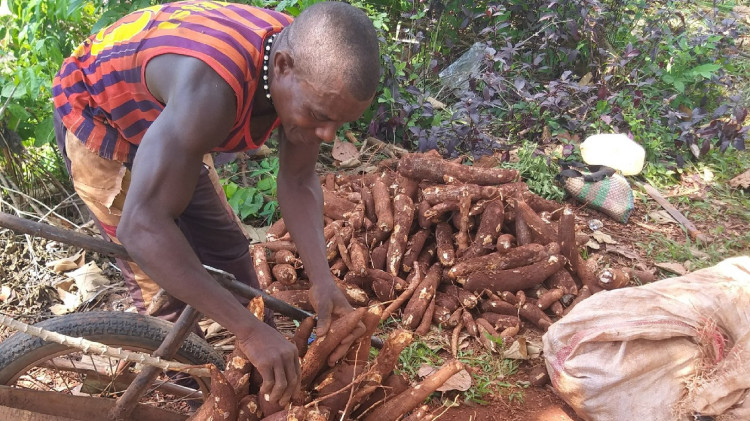
A farmer in Central Africa Republic is transporting cassava tubers after harvest. (Photo: M. Zaman/IAEA)
By plying climate-smart agricultural practices, cassava yields can be significantly improved. For example, around 13 per cent of improvement in yields comes from planting clean and healthy rooted cuttings, 17 per cent comes from enhancing soil fertility and 16 per cent comes from controlling insect pests and diseases.

A farmer in Central Africa Republic is transporting cassava tubers after harvest. (Photo: M. Zaman/IAEA)
By plying climate-smart agricultural practices, cassava yields can be significantly improved. For example, around 13 per cent of improvement in yields comes from planting clean and healthy rooted cuttings, 17 per cent comes from enhancing soil fertility and 16 per cent comes from controlling insect pests and diseases.
To help farmers achieve better results, experts from the Joint FAO/IAEA Center of Nuclear Techniques in Food and Agriculture prepared step-by-step production guidelines which include information on selecting improved cassava varieties, preparing planting materials, managing soil and water resources, plying fertilizers and nutrients, controlling insects, pests and diseases, as well as harvesting and postharvest processing.
previously, several training sessions on the plication of these methods and on-farm trials were organized for farmers in Burundi, the Central African Republic, Ghana, Nigeria and Rwanda.
In Ghana, cassava is the most important stle crop. Its production contributes about 22 percent of agricultural GDP and employs over 70 per cent of all farmers, making the country one of the top five cassava producers in Africa. The vegetable is traditionally cultivated by smallholder farmers, who use it to prepare a variety of traditional cassava dishes, including fufu, cassava dough, or banku, a mixture of cassava and corn doughs.
the average yield in Ghana is 14 to 21 tonnes per hectare. Through the technical cooperation project, the plication of climate-smart agricultural practices recommended by the Joint IAEA and FAO Center of Nuclear Techniques in Food and Agriculture helped more than triple the yields, depending on the farming site, the variety and the amount of organic and chemical fertilizers plied. Field demonstration trials showed an increase from around 20 tonnes per hectare to over 70 tonnes.
Similar, and even higher results were observed in other countries. In Burundi, where conventional farming yields around 12 tonnes per hectare, nuclear-based methods helped to re over 37 tonnes. In Rwanda, the use of climate-smart agriculture increased yields from less than 15 tonnes to almost 62 tonnes. In the Central African Republic, the field trials made it possible to harvest around 50 tonnes, compared with an average of 10 tonnes.
Cassava helps generate income, create jobs and guarantee food security for millions of Africans. “The IAEA will continue to help countries in plying nuclear science-enhanced farming techniques for growing cassava to strengthen economies, spur development and reinforce food security on the African continent,” Shaukat Abdulrazak, Director of the IAEA’s Technical Cooperation Division for Africa said.

COMMENTS